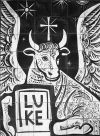
The Gospel of Luke
Jesus chooses the Twelve: Lk 6,12-16
Mark in Mk 3,7-19, gives a summary of Jesus' ministry and follows this by the appointment of the Twelve. Luke has changed these around. The result is that the naming of the Twelve becomes a direct response to the furious rejection of the Pharisees in 6,11. The summary of Jesus' ministry now forms the immediate background to the sermon.
The scene opens with Jesus going up the mountain to pray (6,12). Jesus at prayer is a common theme in this Gospel: the references I gave referred to his baptism, the Transfiguration and to Gethsemane. This is the only time we are told Jesus was at prayer all night. Perhaps this is an indication of the importance of the choice he is about to make.
Jesus at prayer provides a notably different context to the call of the twelve to that of Matthew. I gave a long quotation to indicate how the call of the twelve in Matthew is embedded in Jesus' ministry and how they are immediately sent out by him. In Luke this sending out does not happen until 9,1. Typically for Luke as we saw earlier for the call of the first disciples, 5,1-11, the Twelve must be taught before they are sent.
Luke in verse 13 stresses that Jesus chose the Twelve. Very significant is that Luke says clearly that Jesus named the twelve "apostles" (5,13). "Called them apostles" as in some translations is not strong enough. The leadership of the Apostles which became so important in the tradition of the Church is really a theme of St Luke that comes to great prominence in the Acts of the Apostles. Both Matthew and Mark only use the word incidentally in this scene, more with its functional meaning of "one who is sent". The Gospel of John always speaks of "disciples".
The principal names of the Twelve (6,14-16) are the same in all three evangelists - including Judas Iscariot whose betrayal is mentioned by all, though only Luke calls him a traitor. Of the others whatever they are called, little or nothing is known. Variations therefore don't matter.
Acts 1,13 picks up on this list from 6,14-16 with the same names. The same chapter also shows the qualifications needed for the replacement of Judas Iscariot among the apostles: accompanying Jesus from his baptism through to witnessing the resurrection (Acts 1,21-22).
Return to main page.
Transition to the Sermon
The choosing of the twelve then leads straight into the setting up of the sermon. Luke has edited and shortened Mark with the effect of providing a clear beginning to the sermon.
Jesus came down to "a level place" with them, the Twelve. We can note that they are thus associated with him and his ministry. This is the beginning of their preparation for the future (their "formation" as we might say today).
In this Gospel, Jesus speaks to God on the mountain whereas he speaks to the people on the plain.
As an explanation for the different settings in Matthew and Luke I referred you to the book of Exodus where Moses and the people have reached Mount Sinai (Ex 19,1-15). At the top of the mountain, God speaks to Moses (Ex 19,3-6). At the bottom of the mountain, Moses speaks to the people (Ex 19,7.14). Jesus in Matthew is at the top of the mountain as the giver of the new law (5,1). Jesus in Luke is on the plain speaking among the people as a prophet (see 7.16).
We can see the concentric circles of those gathered around Jesus: the apostles close in, next the wider group of disciples and then the multitude, "great" is used for both. The multitude itself can be divided into two: Jews (from Jerusalem and Judaea) and foreigners (Tyre and Sidon). They come (verse 18) both to hear and to be healed.
In verse 19 we are once again reminded of the power of Jesus, though the Spirit is not mentioned as in 4,14.
Let us now return to our main page.
Return to main page.
